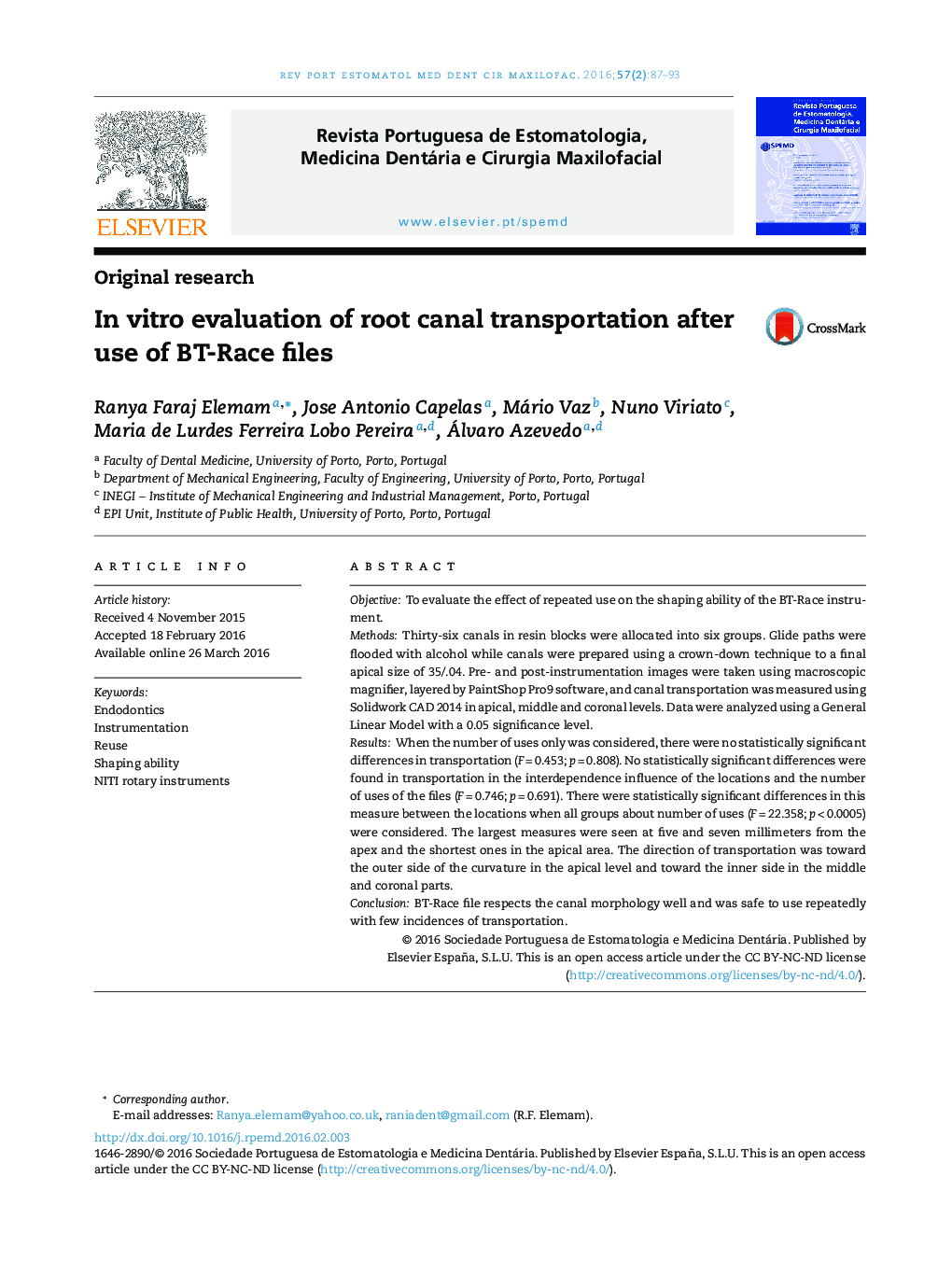| Article ID | Journal | Published Year | Pages | File Type |
|---|---|---|---|---|
| 3173271 | Revista Portuguesa de Estomatologia, Medicina Dentária e Cirurgia Maxilofacial | 2016 | 7 Pages |
ObjectiveTo evaluate the effect of repeated use on the shaping ability of the BT-Race instrument.MethodsThirty-six canals in resin blocks were allocated into six groups. Glide paths were flooded with alcohol while canals were prepared using a crown-down technique to a final apical size of 35/.04. Pre- and post-instrumentation images were taken using macroscopic magnifier, layered by PaintShop Pro9 software, and canal transportation was measured using Solidwork CAD 2014 in apical, middle and coronal levels. Data were analyzed using a General Linear Model with a 0.05 significance level.ResultsWhen the number of uses only was considered, there were no statistically significant differences in transportation (F = 0.453; p = 0.808). No statistically significant differences were found in transportation in the interdependence influence of the locations and the number of uses of the files (F = 0.746; p = 0.691). There were statistically significant differences in this measure between the locations when all groups about number of uses (F = 22.358; p < 0.0005) were considered. The largest measures were seen at five and seven millimeters from the apex and the shortest ones in the apical area. The direction of transportation was toward the outer side of the curvature in the apical level and toward the inner side in the middle and coronal parts.ConclusionBT-Race file respects the canal morphology well and was safe to use repeatedly with few incidences of transportation.
ResumoObjetivoAvaliar o efeito do uso repetido dos instrumentos BT-Race na capacidade de conformação de canais.MétodosTrinta e seis blocos de resina com canais simulados foram divididos em 6grupos. A permeabilidade foi mantida enquanto os canais foram preparados, irrigando-os com álcool e usando uma técnica crown-down até um calibre final de 35/0,04. Foram obtidas imagens pré e pós-instrumentação, usando uma lupa macroscópica, e sobrepostas com auxílio do software PaintShop Pro9. O transporte dos canais foi determinado a nível apical, médio e coronal utilizando o software Solidwork CAD2014. Os dados foram analisados utilizando um modelo geral linear com um nível de significância de 0,05.ResultadosConsiderando apenas o número de utilizações, não se observaram diferenças estatisticamente significativas no transporte dos canais (F = 0,453; p = 0,808). Também não se observaram diferenças com significado estatístico no transporte na influência interdependente das localizações e número de utilizações das limas (F = 0,746; p = 0,691). Existem diferenças estatisticamente significativas nas medidas entre localizações diferentes quando são considerados todos os grupos em relação ao número de utilizações (F = 22,358; p < 0,0005). As maiores medidas obtiveram-se a 5e 7milímetros do ápex e as menores na zona apical. A nível apical a direção de transporte verificou-se para o lado exterior da curvatura e nas porções médias e coronal em direção ao lado interior.Conclusão As limas BT-Race respeitam a morfologia dos canais, podendo ser usadas repetidamente de forma segura provocando pouco transporte dos canais.
